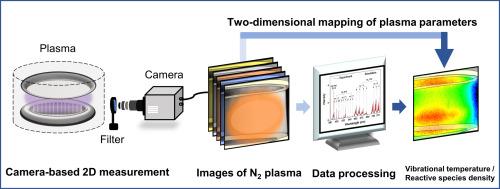Spectroscopic characterization of two-dimensional distributions of vibrational temperature and reactive nitrogen species density in low-pressure nitrogen plasma
IF 4.6
2区 化学
Q1 SPECTROSCOPY
Spectrochimica Acta Part A: Molecular and Biomolecular Spectroscopy
Pub Date : 2025-09-12
DOI:10.1016/j.saa.2025.126913
引用次数: 0
Abstract
The use of a charge-coupled device (CCD) camera, is one of the simplest methods for obtaining high-spatial-resolution plasma diagnostics owing to its ease of use and compatibility with existing setups. Although this approach is effective for atomic gas plasmas when combined with optical bandpass filters, its application in scenarios involving molecular gas plasmas, widely used in semiconductor processes, is challenging due to the limitation of spectral resolution of the filters to resolve densely overlapped molecular emission bands. Therefore, in this study, we developed a CCD-based analysis method using spectrally filtered images to enable two-dimensional mapping of vibrational temperature and reactive nitrogen species density in low-pressure nitrogen plasma. To extract the vibrational temperature, and relative species density from the observed emission intensities, the theoretical intensity ratio was calculated while taking into account the properties of the CCD camera and optical filters. The method achieved a high spatial resolution—better than 0.2 mm across an area of 100 mm × 35 mm. The results obtained exhibited over 84 % agreement with those obtained via conventional spectrum-based analysis. The vibrational temperature of N2(B) and the relative densities of N2(C) and N2+(B) were the highest near the grounded electrode of the plasma reactor, while vibrational temperature of N2(C) was the highest at the powered electrode surface. The results demonstrate that plasma parameters can be rapidly monitored over the entire region in a single measurement using simple optical equipment, without the need for point-by-point scanning as in the conventional method.

低压氮等离子体中振动温度和活性氮密度二维分布的光谱表征。
使用电荷耦合器件(CCD)相机是获得高空间分辨率等离子体诊断的最简单方法之一,因为它易于使用并且与现有设置兼容。虽然这种方法与光学带通滤波器结合使用时对原子气体等离子体是有效的,但由于滤波器的光谱分辨率限制,其在半导体工艺中广泛应用于分子气体等离子体的应用具有挑战性,无法分辨密集重叠的分子发射带。因此,在本研究中,我们开发了一种基于ccd的分析方法,使用光谱滤波图像来实现低压氮等离子体中振动温度和活性氮物种密度的二维映射。为了从观测到的发射强度中提取振动温度和相对物种密度,在考虑CCD相机和滤光片特性的情况下,计算了理论强度比。该方法实现了高空间分辨率,在100 mm × 35 mm的面积上优于0.2 mm。所得结果与传统的基于光谱的分析结果的一致性超过84%。N2(B)的振动温度以及N2(C)和N2+(B)的相对密度在等离子体反应器接地电极附近最高,而N2(C)的振动温度在通电电极表面最高。结果表明,使用简单的光学设备可以在一次测量中快速监测整个区域的等离子体参数,而无需像传统方法那样逐点扫描。
本文章由计算机程序翻译,如有差异,请以英文原文为准。
求助全文
约1分钟内获得全文
求助全文
来源期刊
CiteScore
8.40
自引率
11.40%
发文量
1364
审稿时长
40 days
期刊介绍:
Spectrochimica Acta, Part A: Molecular and Biomolecular Spectroscopy (SAA) is an interdisciplinary journal which spans from basic to applied aspects of optical spectroscopy in chemistry, medicine, biology, and materials science.
The journal publishes original scientific papers that feature high-quality spectroscopic data and analysis. From the broad range of optical spectroscopies, the emphasis is on electronic, vibrational or rotational spectra of molecules, rather than on spectroscopy based on magnetic moments.
Criteria for publication in SAA are novelty, uniqueness, and outstanding quality. Routine applications of spectroscopic techniques and computational methods are not appropriate.
Topics of particular interest of Spectrochimica Acta Part A include, but are not limited to:
Spectroscopy and dynamics of bioanalytical, biomedical, environmental, and atmospheric sciences,
Novel experimental techniques or instrumentation for molecular spectroscopy,
Novel theoretical and computational methods,
Novel applications in photochemistry and photobiology,
Novel interpretational approaches as well as advances in data analysis based on electronic or vibrational spectroscopy.

 求助内容:
求助内容: 应助结果提醒方式:
应助结果提醒方式:


